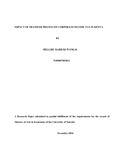| dc.description.abstract | Tax revenue is important for any country since it enables the country’s government to cater for the welfare of her people. In addition, a country that mobilizes adequate tax revenue reduces her budget deficit which translates into reduced external borrowing. Reduced external borrowing is good for economic growth since the amount of country’s revenue which could be used in paying the external debt can be employed in other productive sectors of the economy. This in turn will assist the country to reduce the level of unemployment as well as attracting foreign direct investment. However, most of the developing countries do not mobilize adequate tax as a result of tax evasion. One of the ways in which tax evasion occurs is through transfer pricing by MNCs. For Kenya to achieve her vision 2030 there is need to investigate the effect of transfer pricing on Kenya’s corporate income tax. In Kenya, a few studies have explored external debt service but in different approaches. This study therefore sought to bridge the gap by investigating the effect of external debt service on foreign direct investment inflows for the period between 1980 and 2014. The study used OLS method in estimating long-run co-integrating equation. The study carried out pre-estimation tests so as to validate the results. Among the pre-estimation tests carried out are autocorrelation, heteroscedasticity, multicollinearity and normality test. Stationarity of the variables was further investigated using Augmented Dickey Fuller test.
The estimated results revealed overall significance of the explanatory variables in explaining tax revenue ratio to GDP. The coefficient of determination showed that 85.31 percent of the variation in corporate income tax revenue ratio to GDP is explained by from transfer pricing, agriculture ratio to GDP, net export ratio to GDP, foreign debt ratio to GDP, inflation rate, foreign aid ratio to GDP and GDP growth rate.
The findings further revealed that lag two of foreign debt ratio to GDP to be negative individually significant at 5 percent level of significance in influencing corporate income tax revenue ratio to GDP in the short run. Lag one of GDP growth rate was also revealed to be negative and individually significant at 10 percent level of significance in influencing corporate income tax revenue ratio to GDP in the short run. Further, lag one and lag two of transfer pricing
xi
were also revealed to be negative and individually insignificant in influencing corporate income tax revenue ratio to GDP in the short run.
Based on these study findings, the government of Kenya should focus on reducing foreign debt and also put in place good policies that will enable government to raise more tax revenue as the economy grows. To achieve higher tax corporate tax as the economy grows, government needs to develop policies that will curb transfer pricing so that she obtains higher taxes from MNCs that are registering higher profits in the country. This is because if every MNC pays her share of taxes, there will be no over-taxation of other economic agents and thus tax evasion will be reduced. Reduction in tax evasion will translate into high taxes and thus lead to decrease in foreign debt. | en_US |



